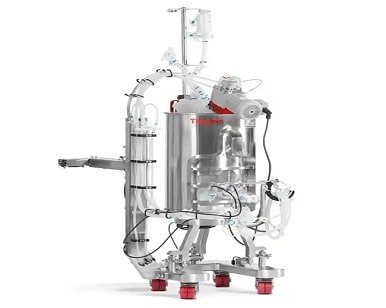Single-Use Bioreactors on the Rise?
The Single-use bioreactors market is projected to grow at a CAGR of 15.82% during the forecast period to reach US$10.786 billion by 2029, from US$3.858 billion in 2022.
Single-use bioreactors are ideal for the manufacturing of biopharmaceutical products, because of their great efficiency. They have advanced significantly in recent years as a result of firms’ never-ending efforts to distribute goods. They may be observed improvising sensor systems, designs, stirring mechanisms, and single-use bioreactor film technology. A disposable bag replaces the reusable steel vessel used in traditional bioreactors in a single-use bioreactor. Large amounts of cells are cultured in single-use bioreactors. In contrast to standard stainless steel multi-user systems, the culture vessel is a plastic bag that is used once and then discarded.
Single-use bioreactors enable processors to use disposable technology, such as single-use bags, in production processes that formerly required stainless steel equipment. The single-use system is the third form of the biopharmaceutical processing system, which is designed to be used for the duration of a single batch of treatments and then destroyed. Single-use technologies are becoming more popular, and they’re reducing product cross-contamination concerns by eliminating the requirement for batch cleaning. These systems, which are manufactured in a cleanroom, double bagged, and sterilized using gamma, EtO, or x-ray sterilization procedures, provide a sterile system for every batch while also being very efficient and cost-effective.
Factors Accelerating the Market:
The growing acceptance of single-use bioreactors among small businesses and start-ups, reduced automation complexity, ease of cultivation of marine organisms, reduced energy and water consumption, the growing biologics market, technological advancements in single-use bioreactors, and the growth of biopharmaceutical research and development are all factors driving the single-use bioreactors market forward. This industry has enormous growth potential in the future due to factors such as the rapid adoption of disposable technology in the pharmaceutical and biotechnology industries, cost-effectiveness and lower downtime of single-use bioreactors, and increased government support for biopharmaceutical research, growing demand for biopharmaceuticals, and frequent launch of new products. License termination and emerging markets are most likely to generate new opportunities for the single-use bioreactors market to grow.
Factors such as the existence of developed biopharmaceutical industry and the presence of large manufacturers operating in the single-use bioreactors market, North America dominates the single-use bioreactors market.
Growing biopharmaceutical industry, growing life science research, escalating investments by pharmaceutical and biotechnology companies, and the increasing number of CROs and CMOs in various emerging economies, Asia Pacific is expected to see significant growth in the single-use bioreactors market.
Factors That Can Restrain the Market:
One of the most significant difficulties for the growth of single-use bioreactors is the requirement for improved single-use sensors and the standardization of single-use layouts. The recurring cost of plastic ware and single-use consumables is determined to be greater than the capital investment. Fixed stainless steel equipment has high upfront costs in terms of installation and maintenance, but single-use bioreactors (SUBs) have greater regular recurrent costs. Furthermore, proper waste management of the enormous numbers of disposables may incur considerable expenditures.
Types of Single-Use Bioreactors
- Media bags: Suppliers gamma-sterilize the bags, which are comprised of multilayer polymer films. Polyethylene is commonly used as the lining of the bioreactor bag that comes into touch with the cell culture. After that, the bag is enclosed in more durable construction, such as a rocker, cuboid, or steel cylinder.
- Filtration assemblies: Vacuum filtration of tissue culture media, biological fluids, HPLC, and other aqueous solutions is performed with this filtration assembly. The unit is designed to enhance flow while minimizing foaming.
- Mammalian Cell: Mammalian cell culture is the method of cultivating cells from mammals in flasks or bioreactors in the laboratory. It’s the process of developing cells outside of their natural habitat. Instead, the growth process is carried out in a growth medium. Eukaryotic cells are those seen in mammals.
Key Developments:
- Captiva and Pall Corporation announced plans to expand their manufacturing capacity and services globally in July 2021, with plans to invest more than USD 300 million in single-use technologies such as bioreactor bags for growing cells used to make syringe filters and customized medicines for research.
- As part of a series of significant investments in its San Diego process development and production activities, Abzena has begun the installation of a new 500L BIOSTAT STR single-use bioreactor.
- A tabletop SUB system for mammalian cell culture and recombinant protein production was recently developed by Distek Inc.
COVID-19 Insights
Many of the world’s largest single-use bioreactor producers are actively collaborating with companies that are developing or testing vaccines. Sartorius, for example, has aided CanSino Biologics Inc. and Maj. Gen. Chen Wei’s team at China’s Academy of Military Medical Sciences’ Institute of Bioengineering in the creation of the first vaccine candidate against the new coronavirus SARS-CoV-2 to enter clinical trials. In some ways, this has had a positive impact on the SUB. The bioprocessing solutions were able to manage COVID-19’s influence on supply chains, production, and shipments to customers. Predictability in the short and medium-term is severely limited and has a small impact. However, because of the COVID-19 outbreak, a reduction in global pharmaceutical R&D spending and a dip in biologics sales in 2020 will have a substantial influence on SUB growth.


